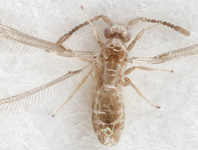Abstract
Males of Enterobius (Colobenterobius) serratus Hasegawa et al., 2003 (Nematoda: Oxyuridae) are described for the first time based on six individuals collected from the feces of proboscis monkeys, Nasalis larvatus, in the Lower Kinabatangan Wildlife Sanctuary, Sabah, Malaysian Borneo. The males show identical cephalic morphology to females, being readily distinguishable from their congeners by the serrated inner margins of the lips. The bicolored esophageal corpus, long thin spicule and developed spicular pouch with paired muscular bands are also remarkable characteristics, presumably shared by other Asian members of the subgenus.
References
Bird, A.F. & Bird, J. (1991) The Structure of Nematodes. 2nd Edition. Academic Press Inc., San Diego, 316 pp.
Chitwood, B.G. & Chitwood, M.B. (1950) An Introduction to Nematology. Monumental Printing Co., Baltimore, Maryland, 213 pp.
Frias, L. (2019) Host-parasite community interactions in a human-modified habitat. Ph. D. Thesis, Primate Research Institute, Kyoto University, Kyoto, 163 pp.
Frias, L., Hasegawa, H., Stark, D.J., Lynn, M.S., Nathan, S.KSS., Chua, T.H., Goossens, B., Okamoto, M. & MacIntosh, A.J.J. (2019) A pinworm's tale: The evolutionary history of Lemuricola (Protenterobius) nycticebi. International Journal for Parasitology: Parasites and Wildlife, 8, 25–32.
https://doi.org/10.1016/j.ijppaw.2018.11.009
Gibbons, L.M. (2002) General organisation. In: Lee, D.L. (Ed.), The Biology of Nematodes. Taylor & Francis, London, pp. 31–59.
https://doi.org/10.4324/9780203166437_chapter_2
Hasegawa, H. (2009) Methods of collection and identification of minute nematodes from the feces of primates, with special application to coevolutionary study of pinworms. In: Huffman, M.H. & Chapman, C.A. (Eds.), Primate Parasite Ecology. Cambridge University Press, Cambridge, pp. 29–46.
Hasegawa, H. & Udono, T. (2007) Chimpanzee pinworm, Enterobius anthropopitheci (Nematoda: Oxyuridae), maintained for more than twenty years in captive chimpanzees in Japan. Journal of Parasitology, 93, 850–853.
https://doi.org/10.1645/GE-1039R.1
Hasegawa, H., Murata, K. & Asakawa, M. (2002) Enterobius (Colobenterobius) pygatrichus sp. n. (Nematoda: Oxyuridae) collected from a golden monkey Pygathrix roxellana (Milne-Edwards, 1870) (Primates: Cercopithecidae: Colobinae). Comparative Parasitology, 69, 62–65.
https://doi.org/10.1654/1525-2647(2002)069[0062:ECPSNN]2.0.CO;2
Hasegawa, H., Matsuo, K. & Onuma, M. (2003) Enterobius (Colobenterobius) serratus sp. n. (Nematoda: Oxyuridae) collected from the proboscis monkey, Nasalis larvatus (Wurmb, 1787) (Primates: Cercopithecidae: Colobinae), in Sarawak, Borneo, Malaysia. Comparative Parasitology, 70, 128–131.
Hasegawa, H., Ikeda, Y., Diaz-Aquino, J.J. & Fukui, D. (2004) Redescription of two pinworms from the black-handed spider monkey, Ateles geoffroyi, with reestablishment of Oxyuronema and Buckleyenterobius (Nematoda: Oxyuroidea). Comparative Parasitology, 71, 166–174.
Hasegawa, H., Greiner, E.C. & Gillespie, T.R. (2008) Morphology of Enterobius (Colobenterobius) colobis Vuylstéke, 1964 (Nematoda: Oxyuridae: Enterobiinae) collected from an ashy red colobus, Procolobus rufomitratus tephrosceles (Elliot, 1907) (Primates: Cercopithecidae: Colobinae) in Uganda. Journal of Parasitology, 94, 1082–1086.
https://doi.org/10.1645/GE-1442.1
Hasegawa, H., Sato, H. & Torii, H. (2012) Redescription of Enterobius (Enterobius) macaci Yen, 1973 (Nematoda: Oxyuridae: Enterobiinae) based on material collected from wild Japanese macaque, Macaca fuscata (Primates: Cercopithecidae). Journal of Parasitology, 98, 152–159.
https://doi.org/10.1645/GE-2867.1
Hasegawa, H., Himani, N., Sasaki, M. & Huffman, M.A. (2018) Description of Enterobius (Colobenterobius) emodensis sp. n. (Nematoda: Oxyuridae) collected from Central Himalayan langur, Semnopithecus schistaceus, in Uttarakhand, India. Zootaxa, 4514 (1), 65–76.
https://doi.org/10.11646/zootaxa.4514.1.5
Hugot, J.P. (1987a) Sur le genre Enterobius (Oxyuridae, Nematoda): s. g. Colobenterobius. I. Parasites de primates Colobinae en région éthiopienne. Bulletin du Muséum National d’Histoire Naturelle, Paris, Série, 9, Section A, No 2, 341–352.
Hugot, J.P. (1987b) Sur le genre Enterobius (Oxyuridae, Nematoda): s. g. Colobenterobius. II. Parasites de primates Colobinae en région orientale. Bulletin du Muséum National d’Histoire Naturelle, Paris, Série, 9, Section A, No 4, 799–813.
Nakano, T., Fukui, D., Ikeda, Y. & Hasegawa, H. (2005) Effects of repeated anthelmitic treatment on Enterobius vermicularis infection in chimpanzees. Journal of Parasitology, 91, 679–682.
https://doi.org/10.1645/GE-412R
Quentin, J.C., Betterton, C. & Krishnasamy, M. (1979) Oxyures nouveaux ou peu connus, parasites de primates, de rongeurs et de dermoptères en Malaisie. Création du sous-genre Colobenterobius n. subgen. Bulletin du Muséum National d’Histoire Naturelle, Série 4 (Zoologie), 1, 1031–1050.
Siddiqi, A.H. & Mirza, M.B. (1954) On a new oxyurid worm, Enterobius zakiri n. sp. from the rectum of Semnopithecus entellus schistaceus (Tarai langur). Indian Journal of Helminthology, 6, 24–26.
Wahid, S. (1961) On two new species of the genus Enterobius Leach, 1853, from a Colobus monkey. Journal of Helminthology, 35, 345–352.
https://doi.org/10.1017/S0022149X00004727
Yen, W.C. (1973) Helminths of birds and wild animals from Lin-Tsan Prefecture, Yunnan Province, China. II. Parasitic nematodes of mammals. Acta Zoologica Sinica, 9, 354 – 364.

